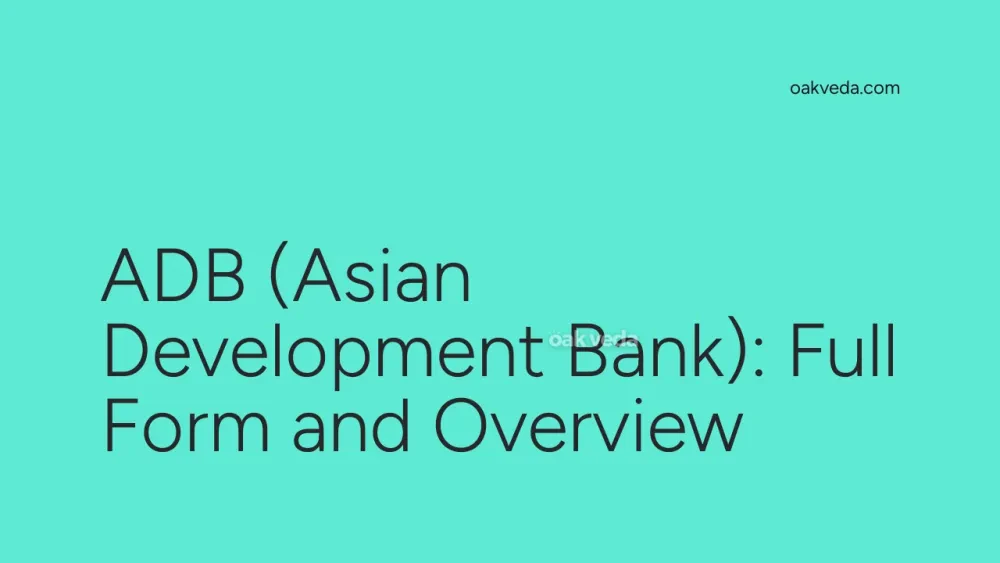
What is the Full Form of ADB?
The full form of ADB is Asian Development Bank. This multilateral development finance institution plays a crucial role in promoting economic growth and cooperation in the Asia-Pacific region.
What is Asian Development Bank?
The Asian Development Bank is a regional development bank established to foster economic growth and cooperation in Asia and the Pacific. It provides loans, grants, and technical assistance to its member countries, focusing on poverty reduction and improving people's lives.
Origin and Development of Asian Development Bank
The concept of ADB emerged in the early 1960s as a response to the need for a regional financial institution to support Asia's development. Key milestones in ADB's history include:
- 1963: The idea was formally proposed at the First Ministerial Conference on Asian Economic Cooperation.
- December 19, 1966: ADB was officially established with 31 member countries.
- 1966-1970s: Initial focus on food production and rural development.
- 1974: The Asian Development Fund was created to provide concessional loans to the poorest member countries.
- 1982: The first field office was opened in Bangladesh, bringing ADB closer to its beneficiaries.
- 1997: ADB played a crucial role in addressing the Asian financial crisis.
- 2008: Launch of "Strategy 2020," a long-term strategic framework to guide ADB's operations.
- 2018: Adoption of "Strategy 2030," outlining ADB's vision and strategic priorities up to 2030.
How does Asian Development Bank work?
ADB operates through a combination of financial instruments and knowledge sharing:
- Loans: Provides both concessional and non-concessional loans to member countries.
- Grants: Offers grant funding for technical assistance and specific projects.
- Technical Assistance: Supports capacity building and policy reforms in member countries.
- Co-financing: Partners with other development organizations and private sector entities.
- Knowledge Sharing: Conducts research and shares best practices in development.
Functions of Asian Development Bank
The primary functions of ADB include:
- Promoting economic growth and regional cooperation
- Reducing poverty in Asia and the Pacific
- Supporting sustainable development initiatives
- Enhancing regional integration and trade
- Addressing climate change and environmental sustainability
- Fostering gender equality and social inclusion
- Strengthening governance and institutional capacity
Applications of Asian Development Bank
ADB's work spans various sectors and areas, including:
- Infrastructure Development: Financing transportation, energy, and urban development projects.
- Education: Supporting initiatives to improve access to quality education.
- Health: Investing in healthcare systems and disease prevention programs.
- Agriculture and Food Security: Promoting sustainable farming practices and rural development.
- Financial Sector Development: Strengthening financial institutions and promoting financial inclusion.
- Private Sector Operations: Catalyzing private investments in developing member countries.
Features of Asian Development Bank
Key features of ADB include:
- Diverse Membership: Comprises 68 members, including 49 from the Asia-Pacific region.
- Triple-A Credit Rating: Maintains the highest credit rating, allowing it to borrow at favorable terms.
- Strong Partnerships: Collaborates with governments, private sector, and civil society organizations.
- Results-Oriented Approach: Focuses on measurable development outcomes.
- Commitment to Sustainability: Integrates environmental and social safeguards in its operations.
Benefits of Asian Development Bank
ADB's activities contribute to:
- Accelerated economic growth in developing member countries
- Improved living standards and reduced poverty
- Enhanced regional cooperation and integration
- Increased resilience to economic shocks and natural disasters
- Promotion of sustainable development practices
- Strengthened governance and institutional capacity
Limitations or Challenges of Asian Development Bank
Despite its successes, ADB faces several challenges:
- Balancing Growth and Sustainability: Ensuring development projects are environmentally sustainable.
- Addressing Income Inequality: Tackling growing disparities within and between countries.
- Adapting to Changing Needs: Remaining relevant as countries' development needs evolve.
- Coordination with Other Institutions: Avoiding duplication of efforts with other development banks.
- Resource Mobilization: Securing adequate funding to meet the region's vast development needs.
Future Developments in Asian Development Bank
Looking ahead, ADB is focusing on:
- Implementing Strategy 2030 to address evolving challenges in the region
- Expanding private sector operations and mobilizing private capital
- Strengthening climate change mitigation and adaptation efforts
- Enhancing digital transformation and technological innovation in its operations
- Promoting regional cooperation and integration in the post-COVID-19 era
FAQs on ADB Full Form
-
What is the primary goal of ADB? ADB's main objective is to promote social and economic development in Asia and the Pacific while reducing poverty.
-
How many countries are members of ADB? ADB has 68 member countries, including 49 from the Asia-Pacific region.
-
When was ADB established? ADB was officially established on December 19, 1966.
-
What types of financial assistance does ADB provide? ADB provides loans, grants, and technical assistance to its member countries.
-
How does ADB differ from the World Bank? While both are multilateral development banks, ADB focuses specifically on the Asia-Pacific region, whereas the World Bank operates globally.
-
Can individuals or businesses apply for ADB loans? ADB primarily works with governments and public sector entities. However, it also supports private sector projects through its Private Sector Operations Department.
-
What is ADB's approach to climate change? ADB is committed to addressing climate change through financing climate-resilient projects and promoting low-carbon development in the region.
You may be interested in:

